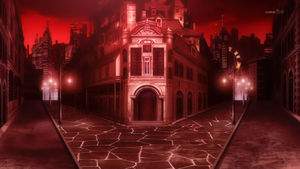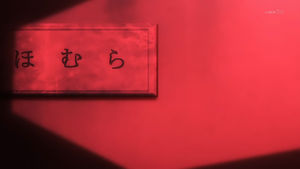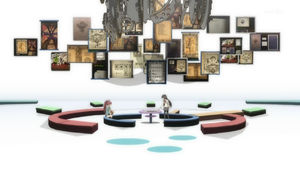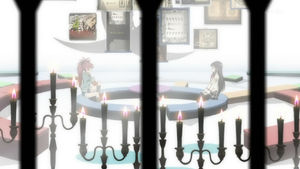Homura Residence: Difference between revisions
| Line 27: | Line 27: | ||
==References== | ==References== | ||
*First pointed out at [http://gall.dcinside.com/list.php?id=anigallers&no=258746&page=2&bbs=Dcinside DCinside]. | *First pointed out at [http://gall.dcinside.com/list.php?id=anigallers&no=258746&page=2&bbs=Dcinside DCinside], a Korean forum. | ||
[[Category:Locations]] | [[Category:Locations]] | ||
Revision as of 20:10, 25 February 2011
This section may contain major spoilers!
Please refrain from reading if you are not yet familiar with all the latest media released.The residence of Homura Akemi. An aging, European-style building at a Y intersection in a district surrounded by skyscrapers. It is unclear if this is a new building or part of the original town that didn't undergo urban redevelopment. Contrastingly, the interior of Homura's apartment is ultra-modern, and the walls appear to be digital displays of documents pertaining to witches. There is a decoration on the ceiling made of clockwork, and the 'desktop' within the digital display features a pair of swinging, bladed pendulums. Along a fourth, unseen wall, there is a row of candlesticks and pillars.
Walpurgisnacht Documents
The following is a gallery of the documents on Homura's wall display.
On a black space between a scan of a Renaissance-era book and a diagram with a sticker that says "Plan A," there is a line of green text that says 1914_Bücher (books?). At center, there is a page with illustrations of what appear to be the humanoid forms of six witches, marked "1/25p." (A similar illustration appears in Episode 4.) At bottom left of the page, "Walpurgisnacht" is printed. At right, there is a less elaborate woodcut image of the Witch from Episode 1 and a photograph of some circular object (the Moon?).
At right, there is a passage from Faust. At center, there is a detail of the "Plan A" document, which appears to diagram the movements of some object or being in red lines across marked regions. At bottom right, the neon green feminine figure is displayed in better resolution, appearing to be descending a spiral staircase. Note also that the framing print of the Faust manuscript also frames several other documents -- they may be from the same book. Within the frame, at top, the Sun pierces the clouds like the iris of an eye, and two birds fly beside it. At bottom, a Moon is suspended above an illegible plaque within a circle of clouds. There are vaguely humanoid figures in the pillars.
At top left, there are the words "Bühnentechnik" (stagecraft) and "Gear" in stylized text. Besides, beneath a drawing of the Witch from Episode 1, there is the word EinNarr (german for 'a fool')." A letter or two may be cut off from the beginning. A thick-lined illustration of the Episode 1 Witch is shown to be a book page opposing the annotated diagram of the half-skirted feminine figure.
The full "Walpurgis Nacht" image is displayed. Also, there is a circular illustration on the page opposing the Faust passage. It appears to be the same pattern that appeared in the sky behind the Episode 1 Witch.
Speculah and Observations
- The apartment layout might represent a clock of some sort, in line with Homura's time manipulation abilities.
- Because the appearance of the apartment interior is quite surreal and bears a superficial resemblance to a Witch's Labyrinth, some viewers have proposed that Homura might have refurbished or reconstituted her flat with magic.
- 2ch has referred to the residence as 「ほむホム」 (homu homu). The first "homu"("ほむ") refers to Homura herself, and the latter comes from the word "home," usually pronounced "ホーム" in Japanese.
- The shadows of the pendulums resemble imagery used in The Pit and the Pendulum by Edgar Allen Poe.[1]
References
- First pointed out at DCinside, a Korean forum.










